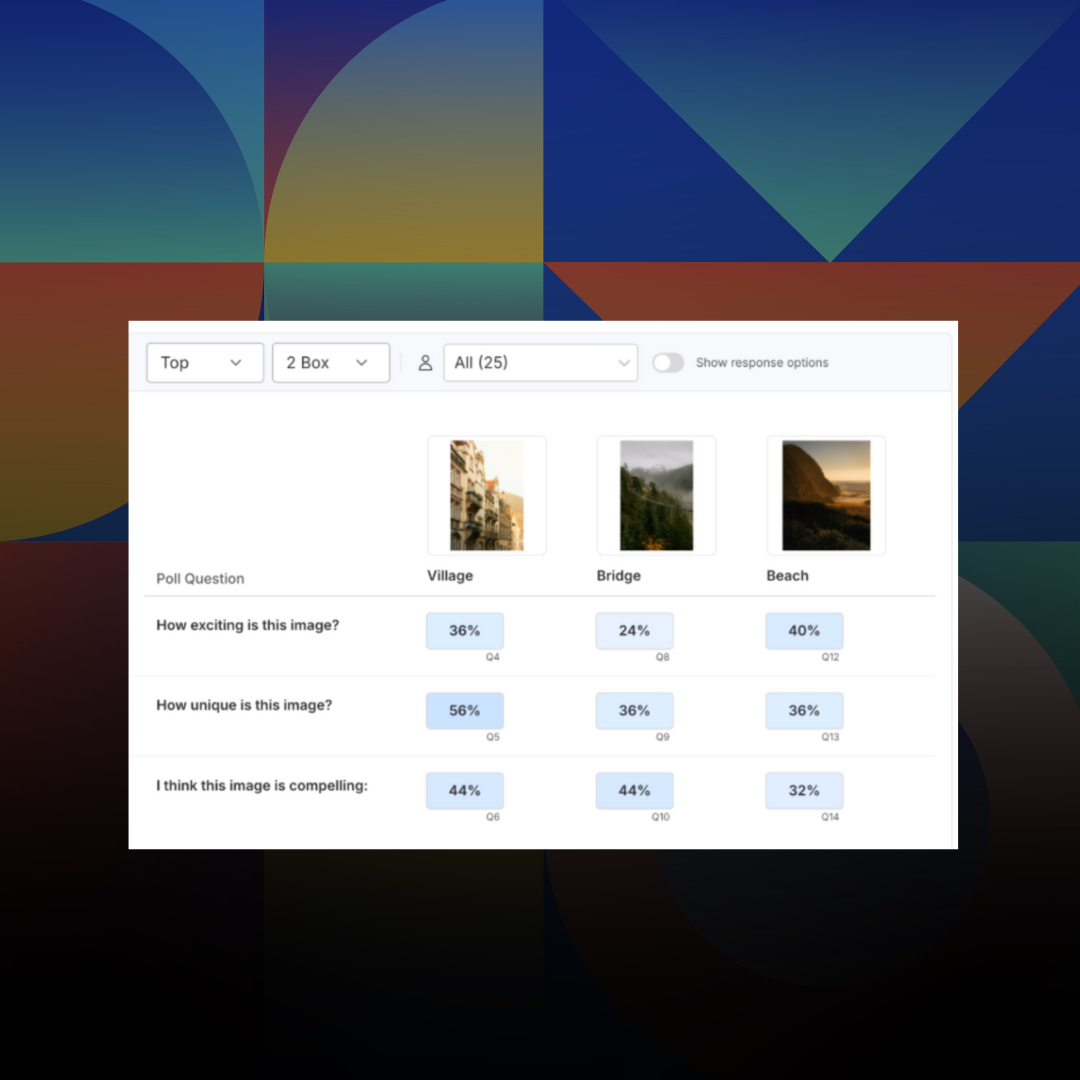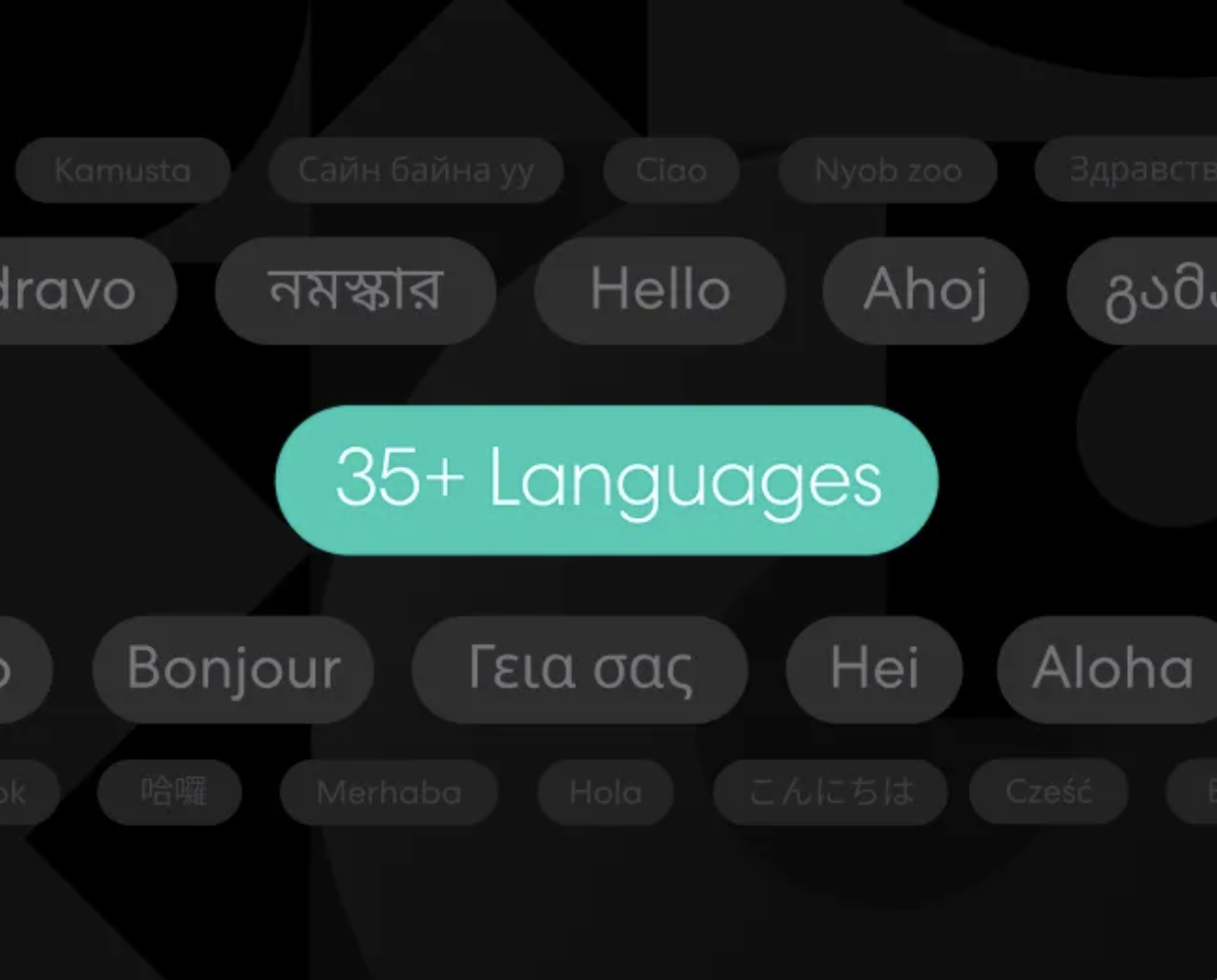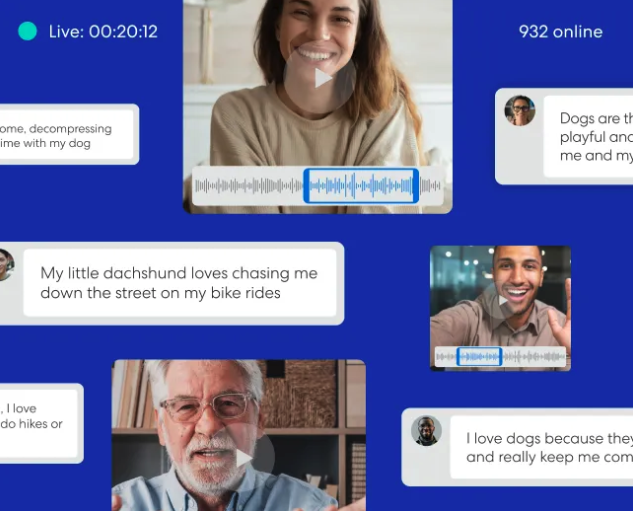
Advanced Research
The Most Cutting-Edge Consumer Insights Software of 2026
Team Remesh
January 5, 2026
Market Research
Articles

Advanced Research
The Most Cutting-Edge Consumer Insights Software of 2026
Team Remesh
January 5, 2026
Market Research
Articles

Research 101
Introducing: Poll Comparison - Streamline Concept Testing and Make Better Decisions Faster
Emmet Hennessy
November 24, 2025
Market Research
Articles

Research 101
Introducing: Poll Comparison - Streamline Concept Testing and Make Better Decisions Faster
Emmet Hennessy
November 24, 2025
Market Research
Articles

AI
Purpose-Built for Research AI is Here - a Letter from the CPO
Jessica Dubin
October 21, 2025
Market Research
Articles

AI
Purpose-Built for Research AI is Here - a Letter from the CPO
Jessica Dubin
October 21, 2025
Market Research
Articles

Advanced Research
Unlock Agile Global Insights: Using Remesh Multi-Language Conversations for Research Across Audiences
Customer Success Team
October 14, 2025
Market Research
Articles

Advanced Research
Unlock Agile Global Insights: Using Remesh Multi-Language Conversations for Research Across Audiences
Customer Success Team
October 14, 2025
Market Research
Articles

AI
The Prompt Is the New Moderator Guide
Anthony Lam
September 16, 2025
Market Research
Articles

AI
The Prompt Is the New Moderator Guide
Anthony Lam
September 16, 2025
Market Research
Articles

AI
Building an AI-Ready Research Stack: Beyond Data Preparation
Anthony Lam
September 9, 2025
Market Research
Articles

AI
Building an AI-Ready Research Stack: Beyond Data Preparation
Anthony Lam
September 9, 2025
Market Research
Articles

AI
Agentic AI for Research: A Practical Primer
Dan Reich
September 2, 2025
Market Research
Articles

AI
Agentic AI for Research: A Practical Primer
Dan Reich
September 2, 2025
Market Research
Articles
5 Ways to Build Brand Equity
Brand equity is the value a brand has in the minds of consumers, and it is often reflected in a brand’s positive or negative reputation with the public.



You can measure the success of your brand in many ways, including traditional markers like revenue and market growth. However, one of the most powerful and challenging to achieve indicators of success is positive brand equity.
Brand equity is the value a brand has in the minds of consumers, and it often reflects in a brand’s positive or negative reputation with the general public. These days, a company’s reputation can make or break its business, so it is more important than ever for your brand to pay close attention to its brand equity.
Businesses with high brand equity like Nike, Google, Amazon, and Starbucks can charge a higher price premium for products or services, build loyal customers, and efficiently expand their company’s market share. Businesses with negative brand equity and poor perceived quality risk decreased revenue and poor brand reputation.

Five Ways You Can Start Building Positive Brand Equity

Connect With Your Target Audience
If you want to build brand equity, you need to connect with your target audience. Connecting with your target market allows you to measure how consumers feel about your brand. There are many solutions you can use, including:
- Search Volume: How often are consumers searching for your brand name online? You can learn a lot about what consumers think by digging into your online data. If consumers aren’t searching for you online, it could mean your brand awareness is low. Search volume data is a low-cost way to measure your brand awareness.
- Social Media: Are your customers posting about your brand on social media? Many consumers now use social media to keep up with their favorite brands. Look at engagement metrics, including comments, likes, and shares on your social media accounts.
- Social data can help you understand how consumers feel about your brand. This solution delivers rich insights into your business's positive and negative consumer opinions — plus, there are several options in the social media listening space to choose from.
- Social media live streaming is another popular marketing maneuver of the digital business landscape that can significantly aid you in connecting with your audience. Using professional live streaming tools like OneStream Live, you can use pre-recorded and real-time video broadcasts to interact with your customers in real-time and build brand awareness and reputation.
- Focus Groups: What do your customers think about your brand? One of the best ways to connect with consumers is by conducting targeted focus groups. Focus groups allow you to collect feedback directly from consumers about your brand.
- Focus groups can be one of the most effective ways to gather insights into your brand. However, in-person focus groups can be costly and time-consuming.
- Online focus groups are increasingly more popular than in-person focus groups. Solutions powered by artificial intelligence (AI) and natural language processing (NLP), like Remesh, offer a faster time to insights than traditional focus groups. They can also reach a larger audience – anywhere in the world. These solutions can be beneficial for brands that want reduced research time and at-scale data.
Read: Online Focus Groups vs Traditional Focus Groups

Build Brand Awareness
One of the simplest ways to build brand equity is by simply increasing consumer awareness.
Consider brands like Coke, Kleenex, or Starbucks. These companies have created such powerful brand awareness that their names immediately appear in conversations about soda, tissues, and coffee. Building this level of brand awareness takes time, but starting with a framework like Keller’s Customer-based Brand Equity Model can result in a quicker time to success.

Keller’s Customer-based Brand Equity Model
One of the most commonly used models for measuring brand equity and awareness is Keller’s customer-based brand equity model (CBBE).

Marketing professor Kevin Lane Keller developed this framework, and it illustrates how you can build brand equity from the bottom up.
- Brand Identity: At the bottom of the CBBE pyramid is Brand Identity. This level is all about uncovering your unique selling points (USP) and conducting research to understand your target audience. This is a fundamental level of Keller’s Brand Equity Model. At this level, your brand should focus on your existing and potential customers and build a clear brand identity and value proposition around customer needs.
- Brand Meaning: After establishing your brand identity, it’s essential to deliver consistent performance and imagery. Brand performance is how you deliver on promises, customer service, product durability, price, and consumer satisfaction. Brand imagery is how your brand appears to your consumers. Some examples include moving images an organization brings to mind, like cozy, chic, eco-friendly, or trendy. At this level, your brand should focus on creating a consistent, truthful image that represents addressing customer concerns.
- Brand Response: Brand response accounts for customer judgments and feelings about an organization. This can be accomplished through brand perception surveys, tracking consumer feedback, and creating special discounts and rewards to incentivize new customer conversion. At this level, your brand should focus on making the business relevant and valuable to new and prospective customers.
- Brand Resonance: The top of the CBBE pyramid is brand resonance. This level represents the peak of your brand’s hard work to build brand equity and awareness. Your brand can reach this level when you have successfully created loyal customers who then become brand advocates. At this level, your brand should focus on identifying why your customers are loyal and building additional incentives to continue building on your brand’s momentum.

Create a Positive Customer Experience
High-quality products are excellent tools for building brand equity. However, a positive customer experience can be the difference between a one-time customer and a loyal customer. According to Forbes, 84% of companies that work to improve customer experience see an increase in revenue. Creating a positive customer experience is a simple and effective way to turn your current customer base into loyal brand consumers.
Read: The ABC Strategy for Customer Feedback Management

Case Study: Amazon
Amazon is an expert in building a positive customer experience. The tech giant specifically designed this return policy and simple customer rating system around consumer needs. These features are value adds for customers, and the positive user experience makes customers want to keep using Amazon.
Think about what needs your consumers might have and how you can create solutions that meet those needs. When customers feel valued, they are more likely to remain loyal to a brand.

Leverage Strategic Partnerships with Reputable Brands
Sometimes a little bit of teamwork is what you need. A brand partnership is an agreement between two or more companies, organizations, or businesses that help generate buzz, build consumer trust, and add value to your business.

Case Study: Doordash
One example of a successful brand partnership was between delivery service Doordash and convenience store 7-11. Both organizations saw an opportunity and worked together to create affordable online delivery from 7-11 for Doordash customers.
For 7-11, this partnership opened up online delivery options that they did not need to create or manage. For Doordash, the partnership with the established 7-11 brand helped build buzz about the app and increased trust in the business.
There are many ways to create partnerships with other brands. Some businesses explore co-branded products and product lines and co-sponsoring events. These partnership opportunities can help new and established brands and can increase profit margins and positive brand equity.

Watch Out: Brand Extension Vs. Brand Dilution
Brand partnerships often go hand-in-hand with a product line or service expansion, but a brand must balance expansion with over-extension and avoid brand dilution.
Brand extensions occur when businesses release new products or services in additional markets. When done successfully, this can increase consumer buy-in and reduce the cost of new market entry. Brand dilution occurs when a product or service extension weakens the overall brand equity.
Brand dilution can happen for many reasons, including:
- Excessive brand extensions. A brand releases too many products or services in the same market without the infrastructure necessary to support the expansion.
- Inconsistency. When a brand enters a market with a product or service that does not align with the brand’s core mission and values.
- Bad products or irrelevant markets: When a brand enters a market space that does not relate to its industry or creates poor quality products.
- Poor partnerships. When a brand partnership does not logically align or diminishes the quality or value of one or both brands through the partnership.
So, how do you avoid brand dilution and focus on successful brand extension? There is no magic formula, but experts suggest leveraging consumer involvement, centering brand consistency, protecting and prioritizing your brand’s flagship products and services, and clearly defining and separating your brand expansions and partnerships.

Build Brand Loyalty
Creating brand loyalty is a crucial brand management strategy. Gaining new customers is more expensive than keeping existing ones, which means building trust with your current consumer base is often as profitable as it is strategic. So, how do you turn your customers into lifelong brand consumers?
- Watch consumer preferences: One of the ways that Spotify built brand loyalty was through personalization. By monitoring the needs and interests of their users, Spotify was able to identify an interest in custom playlists. Responding to consumer preferences tells customers that their opinions matter to a company and helps build brand loyalty.
- Create incentives: Find simple ways to create connections with your consumers. Birthday rewards, seasonal messages, annual events, and small gifts or coupons are effective ways to make current customers feel appreciated. They also create more opportunities to drive business and re-engage less frequent consumers.
- Build loyalty programs: Trusted brands like Sephora, Starbucks, REI, Amazon, and Apple use loyalty programs to build lifelong customers. Each program is different, but all rely on building a community of consumers and rewarding repeat business.
Some rewards programs, like REI, offer exclusive sales to members for free. Amazon charges a small price in exchange for premium services like faster delivery and reduced delivery fees on select products. These programs encourage customer loyalty and boost brand equity.
Read: 3 Companies That Built Brand Loyalty (and How They Did It)

Start Building Brand Equity Today
Building brand equity can be a long and costly process. These five strategies are excellent starting points on your journey to build public trust and loyalty.
Positive brand equity can increase profitability, build a loyal customer base, and expand a company’s market share. As you try these strategies, it’s important to keep the voice and needs of your target customers in mind. The key to building positive emotional connections with consumers starts with listening to your customers.
-
Lorem ipsum dolor sit amet, consectetur adipiscing elit. Suspendisse varius enim in eros elementum tristique. Duis cursus, mi quis viverra ornare, eros dolor interdum nulla, ut commodo diam libero vitae erat. Aenean faucibus nibh et justo cursus id rutrum lorem imperdiet. Nunc ut sem vitae risus tristique posuere.
-
Lorem ipsum dolor sit amet, consectetur adipiscing elit. Suspendisse varius enim in eros elementum tristique. Duis cursus, mi quis viverra ornare, eros dolor interdum nulla, ut commodo diam libero vitae erat. Aenean faucibus nibh et justo cursus id rutrum lorem imperdiet. Nunc ut sem vitae risus tristique posuere.
-
More


Introducing: Poll Comparison - Streamline Concept Testing and Make Better Decisions Faster

.png)

.png)
Read More

.png)
.png)
.png)

.png)

.png)
Learn More

.png)
.png)
.png)

Stay up-to date.
Stay ahead of the curve. Get it all. Or get what suits you. Our 101 material is great if you’re used to working with an agency. Are you a seasoned pro? Sign up to receive just our advanced materials.






